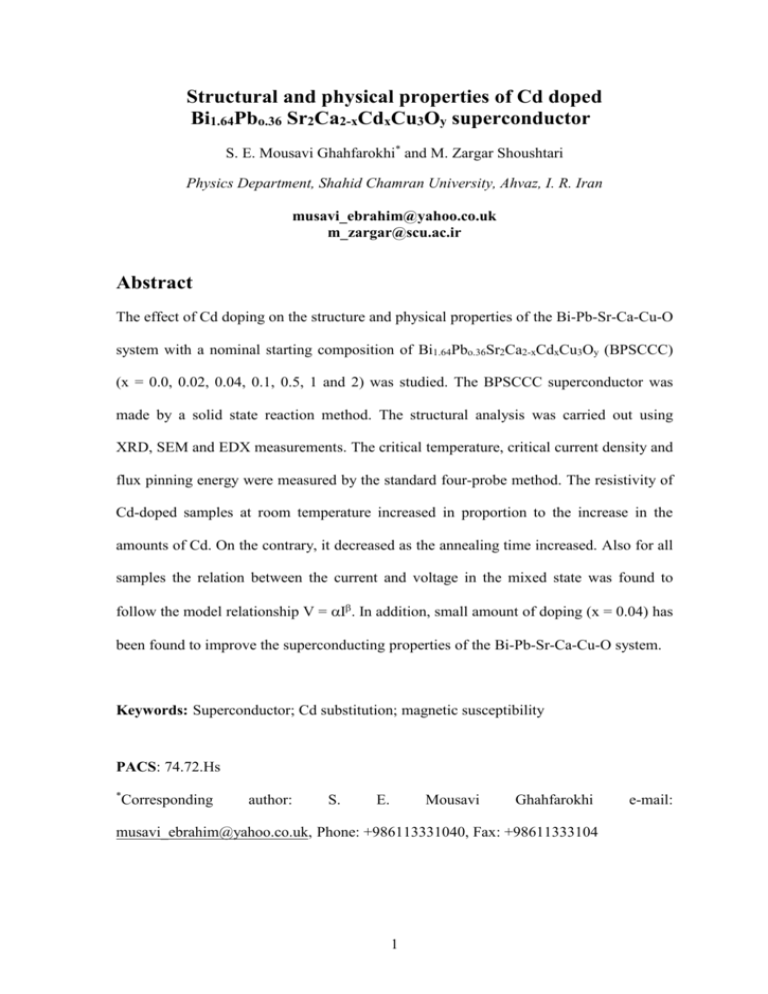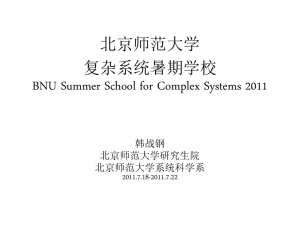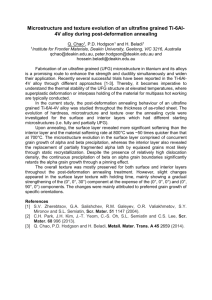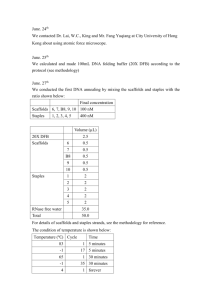Structural and physical properties of Cd doped Bi1
advertisement

Structural and physical properties of Cd doped Bi1.64Pbo.36 Sr2Ca2-xCdxCu3Oy superconductor S. E. Mousavi Ghahfarokhi* and M. Zargar Shoushtari Physics Department, Shahid Chamran University, Ahvaz, I. R. Iran musavi_ebrahim@yahoo.co.uk m_zargar@scu.ac.ir Abstract The effect of Cd doping on the structure and physical properties of the Bi-Pb-Sr-Ca-Cu-O system with a nominal starting composition of Bi1.64Pbo.36Sr2Ca2-xCdxCu3Oy (BPSCCC) (x = 0.0, 0.02, 0.04, 0.1, 0.5, 1 and 2) was studied. The BPSCCC superconductor was made by a solid state reaction method. The structural analysis was carried out using XRD, SEM and EDX measurements. The critical temperature, critical current density and flux pinning energy were measured by the standard four-probe method. The resistivity of Cd-doped samples at room temperature increased in proportion to the increase in the amounts of Cd. On the contrary, it decreased as the annealing time increased. Also for all samples the relation between the current and voltage in the mixed state was found to follow the model relationship V = I. In addition, small amount of doping (x = 0.04) has been found to improve the superconducting properties of the Bi-Pb-Sr-Ca-Cu-O system. Keywords: Superconductor; Cd substitution; magnetic susceptibility PACS: 74.72.Hs * Corresponding author: S. E. Mousavi Ghahfarokhi musavi_ebrahim@yahoo.co.uk, Phone: +986113331040, Fax: +98611333104 1 e-mail: 1. Introduction The critical temperature of the Bi-Sr-Ca-Cu-O system was shown to be 105 K by Meada [1]. The Bi2Sr2Can-1CunOy system has layered structure, and according to their chemical compositions it has three different phases which are called the Bi-2201 phases (n = 1, Tc 20K), the Bi-2212 phase (n = 2, Tc 85K) and the Bi-2223 phase (n = 3, Tc 110 K). Here, we have used the abbreviation Bi-2201, Bi-2212 and Bi-2223 phases for n =1, 2 and 3, respectively. In these series, the Bi-2223 phase is the most attractive, because it has the highest critical temperature, Tc, about 110 K [2, 3]. It is generally known that chemical doping plays a very important role in high-Tc superconductivity. A large number of elements have been doped into the Bi-Sr-Ca-Cu-O system [4]. However, the preparation of the Bi-2223 Phase is too difficult and its formation is influenced by many preparation conditions such as, composition, annealing time and temperature, atmosphere and pressure during sintering, type and quantity of the dopant, heat-treatment method, and operational procedures. Takano and et al showed that the incorporation of Pb in the nominal composition of this system is very effective in increasing the volume fraction of the high Tc phase [5-12]. Since the discovery of Bi-2223 superconductor, great progress has been achieved in enhancing transport properties of this high-Tc superconductor. However, the major limitations of the Bi-based superconductor application are the intergrain weak links and weak flux pinning capability. The one of the major current limiting factors in Bi-2223 phase is the presence of residual secondary phases. The analysis of samples revealed that the Bi-2201 phase was located mainly between the superconducting grains and preventing the super current flow [13]. The partial replacements of Ca by Y and Gd in the Bi-2212 and Bi-2223 phases decreased carrier concentration due to structural modulations and changes in the valence of Cu 2 [14-16]. The tremendous effort has been applied to improving the links between the grains and the properties of the Bi-based superconductor, such as doping of them by Sn and Sb [17,18], Ag [19, 20], Cd [21, 22] and Zr, Hf, Mo, and W [23]. In this work the effects of Cd substitution instead of Ca in Bi1.64Pbo.36Sr2Ca2-xCdxCu3Oy (x = 0.0, 0.02, 0.04, 0.1, 0.5, 1 and 2) system was studied. The critical temperature, critical current density, flux pinning energy, magnetic susceptibility, and microstructure properties of a series of samples were studied. 2. Material and methods Samples of Bi1.64Pbo.36Sr2Ca2-xCdxCu3Oy with x = 0.0, 0.02, 0.04, 0.1, 0.5, 1 and 2, were prepared by the solid state reaction method. The fine powders of Bi2O3, PbO, SrCO3, CaCO3, CuO and CdO with high purity were used. The required quantities of reagents were weighed (m = 10-4mg). In order to prevent the growth of additional phases during the process, the powders were ground and milled for an hour. The mixed powders were calcined at 1093 K for 15 hours in air. Then they were taken out from the furnace, re-ground, and pressed (with 250 bars) into the shape of pellets and bars. Then, they were put in an alumina crucible and placed in the furnace and the procedure of sintering was done at 1118 K in an air atmosphere. All of the samples were given the Meissner effect test in liquid nitrogen. The critical temperature (at a constant DC current of 40 mA), flux pinning energy, and the critical current density of the samples were measured by the standard four-probe method. The AC magnetic susceptibility measurements were performed using a Lake Shore AC susceptometer, Model 7000. The X-ray diffraction (XRD) patterns of the samples were taken with a Philips X-ray diffractometer Model 3 PW1840. The microstructure characterization was performed, by SEM and EDX using a scanning electron microscope Model 1455VP made by of the LEO Company. 3. Results and discussion The XRD measurements of the samples are shown in figure 1. Based on the XRD measurements, as is observed that by substitution of Cd instead of Ca up to an amount of x = 0.04, the Bi-2223 phase increases in the sample and Cd seems to act as a phase stabilizer. As one can see, the samples consist of a mixture of Bi-2223, Bi-2212 and Bi-2201 phases as the major constituents. Also the XRD measurements shows that the volume of Bi-2223 phase decreases with increasing Cd content (sample c) and the optimum amount of cadmium is about x = 0.04 (sample b), which has the highest volume fraction of Bi-2223 phase. The volume fraction of the phases can be estimated by various methods. The all of the peaks Bi 21.8112 Bi1.6 Pb0.04 Sr1.81CaCu2 O8.716 of the Bi-2223, Bi-2212, Bi-2201, CdO and Cd phases have used for the estimation of the volume fractions of the phases and ignored the voids peaks. The percentage of each phase in the samples was calculated as follows: Bi (2223)(%) I Bi 2223 100 Bi (2201)(%) I Bi 2201 100 Cd (%) Bi (2212)(%) A Bi 21.8112% A I Cd 100 I Bi 2212 100 I Bi 21.8112 100 CdO% A 4 A A I CdO 100 A where A I Bi 2223 I Bi 2212 I Bi 2201 I Bi 21.8112 I Cd I CdO and "I" is the intensity of the phases present in the sample. The volume fractions of the phases for all the samples were given in the table 1. As is shown in the table 1, the maximum volume fraction of Bi-2223 phase is obtained for the sample with x = 0.04 (sample b). By increasing the amounts of Cd to more than 0.04, the volume fraction of the Bi-2223 phase will decrease. By decreasing x to amounts less than 0.04, the volume fraction of the Bi-2223 phase also will decrease. Figure 2 shows that the temperature dependencies of the real, , and imaginary, , are parts of the AC magnetic susceptibility for samples with amounts of x = 0.0 and 0.04 in ac field of 50 A/m with a frequency of 333 Hz which is applied parallel to the long dimension of samples. In particular, the imaginary component, , of the AC magnetic susceptibility has been widely used to probe the nature of weak links in polycrystalline superconductors. They are also employed to estimate some of the important physical properties, such as the critical current density and the effective volume fraction of the superconducting grains [24]. The real part of the AC magnetic susceptibility, , in polycrystalline samples shows two drops as the temperature is lowered below the onset of the diamagnetic transition and correspondingly the derivative of the (T) and displays two peaks. The first sharp drop at the critical temperature is due to the transition within the grains and the second gradual change is due to the occurrence of the superconducting coupling between grains. The imaginary part, , shows a peak which is a measure of the dissipation in the sample. When the peak of shifts to lower temperatures and broadens, the interganular coupling between the grains, the critical current density and the flux pinning energy will decrease. The curves shows that the interganular coupling between the grains, the critical current density, and the flux pinning energy of the samples are 5 increased by increasing the amount of cadmium up to x = 0.04. Therefore, the interganular coupling between grains, the critical current density and the flux pinning energy in the sample x = 0.04 is better than the sample x = 0.0. The results of AC-magnetic susceptibility measurements are shown in figure 3 – (a), (b) and (c) for the samples with x = 0.0, 0.02 and 0.04 with and an annealing time of 270 hours for various ac fields. The diamagnetic onset temperature of the intrinsic superconducting transition for these samples is about 107.5 K. It is clear from figure 3 that as the field increases the peak of shifts to lower temperatures and will broaden. Also, the effect of field on the intergranular component in the real part ( ) shifts to lower temperatures. The amount of shift is as a function of the field amplitude, HAC, which is proportional to the strength of the pinning force. When the pinning force becomes smaller, it shows that the critical current will decrease. As seen in the figure 3 by increasing the HAC of the sample with x = 0.04, is more stabilized than the others. This is not only dose of Cd act as a Bi-2223 phase stabilizer; it is also caused some improvement in connectivity between the grains. As figure 4 shows that by increasing x = 0.0 to = 0.04, Tc (onset) and Tc (offset) of the samples will increase. When the amount of cadmium is more than 0.04, Tc (onset) and Tc (offset) of the samples are decrease. The -T curves are shown in figure 5 for the sample with x = 0.04 at different annealing time. One can observe that by increasing the annealing time (t) up to 270 hours, Tc (onset) and Tc (offset) of the samples will increase. The results of measurements show that the maximum Tc (onset) and Tc (offset) were found for sample of the Bi1.64Pb0.36Sr2Ca1.96 Cd0.04Cu3Oy, which annealed for 270 hours. The Tc (offset) versus the Cd content is shown in tables 2, 3 and 4 for different sintering times. Clearly show that the Tc (offset) of the samples increase by increasing the amount of Cd up to x = 0.04 and then the Tc (offset) extremely decreases for x 0.04. Also, by 6 increasing the sintering time up to 270 hours, the Tc (offset) of the sample will increase. The enhancement of the Bi-2223 phase in the sample will increase the Tc (offset). In addition, the XRD data show that by increasing the Cd content to more than 0.04, the amounts of the other phases in the Bi-Sr-Ca-Cu-O system will increase, which causes a decrease in the Tc (offset). Therefore, the maximum of the Tc (offset) were observed for the sample with Cd content of 0.04 and sintering time of 270 hours. In tables 2, 3 and 4 also are shown that by increasing the sintering time up to 270 hours, the Tc (offset) of all the samples will increase. The results of this investigation are consistent with the results of the XRD measurements shown in Fig. 1. The curves V – J are shown in figure 6 for the sample with x = 0.04 at different annealing time. One can observe that by increasing the annealing time, the critical current densities of the samples will increase. As annealing time is increases, the pinning energy will also increase. Figure 7 shows that the V-J curves for doped samples with different amounts of Cd after an annealing time of 270 hours. The critical current density (Jc) versus the amount of Cd in the samples is shown in tables 2, 3 and 4 for different annealing times. Our observations suggested that not only dose Cd (x = 0.04) act as a Bi-2223 phase stabilizer, but also is causes some improvement in connectivity between the grains. Tables 2, 3 and 4 show that if the Cd content up to 0.04; the Jc will increase as well. The maximum Jc was found for Bi1.64Pb0.36Sr2Ca1.96Cd0.04Cu3Oy, annealed for 270 hours. When the amount of cadmium is more than 0.04, the amount of unwanted phases, such as Bi-2212 and Bi-2201, are increase in the sample. These unwanted phases play the role of weak links and will decrease the critical current density. It is shown that the Bi-2201 phase locates mainly between the superconducting grains, and preventing the super-current flow. It was also shown that Jc was raised as the Bi-2212 phase decreased in Bi-2223 tapes [25]. 7 The room temperature V–I curves are shown in figure 8 for the sample with x = 0.04 at different annealing times. One can see that the normal state resistance of the samples will decrease by increasing the annealing time. This means that the junctions between the grains have been improved in the sample by increasing the annealing time. The curves V-I are shown in figure 9 for different amounts of Cd after an annealing time of 270 hours at room temperature. It can conclude that for the amounts of cadmium are more than 0.04, the resistance of normal state of the samples will increase. Because, by adding a higher amount of CdO to the samples, the other unwanted phases would form. These phases will weaken the junctions between the grains and therefore, the electrical resistance of normal state will increase. The resistance (R) of the doped samples as a function of the cadmium content is shown in tables 2, 3 and 4 for different annealing times at room temperature. By increasing the annealing time up to 270 hours, the R will decrease as well. So, the minimum R was found for Bi1.64Pb0.36Sr2Ca1.96Cd0.04Cu3Oy sample, annealed for 270 hours. When the amount of cadmium is more than 0.04 the R of the samples will increase. Because, by adding a higher amount of CdO to the samples, other unwanted phases would form. These phases will weaken the junctions between the grains and therefore, the electrical resistance of the normal state will increase Moreover, for all samples, the relation between the current and voltage in the region between Jco (onset of resistive state) and Jc (onset of normal state) follows the power law model of V I [26, 27] which one of the sample curves is shown in Fig. 10. These results have been derived from of curves logV- logI (see Figs. 11 and 12) which are plotted in the region between Jco and Jc. The value of for each sample is calculated. Considering the value of and the relationship of = U/kBT [28], where U is the pinning potential, it can be concluded that prolongation of annealing time, leads to an increase in 8 flux pinning energy. In other words, the average force on the flux for depinning will increase. The flux pinning energy (U) versus the amount of Cd in the samples are shown in tables 2, 3 and 4 for different annealing times. These tables show that if increase the Cd content, U also will increases. Also, by increasing the annealing time up to 270 hours, U, will increases as well. So, the maximum U was found for Bi1.64Pb0.36Sr2Ca1.96Cd0.04Cu3Oy annealed for 270 hours. When the amount of cadmium is more than 0.04, the amounts of unwanted phases, such as Bi-2212 and Bi-2201, will increase in the sample. These unwanted phases play the role of weak links and decrease the flux pinning energy. The result of EDX measurements show that there is no unwanted element in the samples, which means, the samples are not contaminated during the synthesis process (see Fig. 13). The SEM micrographs are shown in figure 14- (a), (b) and (c) for the samples, with amounts of cadmium (x) = 0.0, 0.04 and 2 and with annealing time of 270 hours. It shown that the sample with x = 2 (c) is partially melted. It seems increasing the amount of Cd leads to the formation of a liquid phase that act as an insulating layer around the superconductor grain. Also, for the amount of x = 0.0 (b) leads to the formation of more pores. These pores act as a weak links between the grains. These pores and insulators layers destroy grains connectivity and disrupt current flow. These results are in agreement with the results of the X-ray diffraction measurements and the critical current densities. Figure 15- (a) and (b) show that the SEM micrographs for samples with the annealing time 90 and 270 hours with cadmium content of 0.04. It seems that the increasing of annealing time leads to the formation of the larger grains and also fewer pores. So that, 9 the gradual increase of the critical current density is observed with increasing the annealing time. Conclusion In this work the role of Cd in the synthesis of Bi1.64Pb0.36Sr2Ca2-xCdxCu3Oy superconductor with x = 0.0, 0.02, 0.04, 0.1, 0.5, 1 and 2 was investigated. The samples were prepared by solid state reaction method using different annealing times. The results of magnetic susceptibility measurements for the samples show that the diamagnetic fraction of the sample with x = 0.04 is greater than the other samples. From the results, It can conclude that the sample doped with cadmium having x = 0.04 and with annealing time of 270 hours, has an increase in percentage of the Bi-2223 phase. The measurement also are shown that the maximum value of the critical current density, the flux pinning energy and the critical temperature were obtained for the sample with annealing time of 270 hours and Cd content of 0.04. Also the results are shown that the Bi-2223 phase is converted to Bi-2212 phase for concentrations x 0.1, this due to the strong phase transition occurred at x = 0.1 with consequent decrease in Tc (offset) due to the formation of the weak links. References [1] H. Maeda, Y. Tanaka, M. Fukutomi, T. Asano, A new high-T (c) oxide superconductor without a rare earth element, Jpn J. Appl. Phys., 27 (1988) L209-L210. [2] K. A. Sarkar, I. Maartense, T. L. Peterson and B. Kumar, Preparation and characterization of superconducting phases in the (Bi,Pb)-Sr-Ca-Cu-O system, J. Appl. Phys., 66 (1989) 3717-3722. 10 [3] C. K. Rhee, C. J. Kim, H. G. Lee, I. H. Kuk, J. M. Lee, I. S. Chang, C. S. Rim, P. S. Han, S. I. Pyun and D. Y. Won, Effect of Pb content on the formation of the high-Tc phase in the (Bi, Pb)-Sr-Ca-Cu-O system, Jpn. J. Appl. Phys., 28 (1989) L1137-L1139. [4] J. C. Grivel, A. Jeremie and R. Flukiger, The influence of TiO2 additions on the foramation and the superconducting properties of the (Bi,Pb)2Sr2Ca2Cu3O10-y phase, Supercond. Sci. Technol., 8 (1995) 41-47. [5] W. Zhu and P. S. Nicholson, Atmosphere temperature-time relationships for the formation of 110 K phase in the Bi-Pb-Sr-Ca-Cu-O high Tc – superconductor system, Appl. Phys. Lett., 61 (1992) 717-719. [6] M. Takano, J. Takada, K. Oda, H. Kitaguchi, Y. Miura, Y. Ikeda, Y. Tomii and H. Mazaki, High Tc phase promoted and stabilized in the Bi-Pb-Sr-Ca-Cu-O system, Jpn. J. Appl. Phys., 27 (1988) L1041-L1043 . [7] S. X. Dou, H. K. Liu, A. J. Bourdillon, M. Kviz, N. X. Tan and C. C. Sorrell, Stability of superconducting phase in Bi-Sr-Ca-Cu-O and the of Pb doping, Phys. Rev. B, 40 (1989) 5266-5269 . [8] M. Pissas, D. Niarchos and M. Anagnostou, The optimum percentage of Pb and the appropriate thermal procedure for the preparation of the 110 K Bi2-xPbxSr2Ca2Cu3Oy superconductor, Supercond. Sci. Technol., 3 (1990) 128-133. [9] M. Borik, M. Chernikov, I. Dubov, V. Osiko, V. Veselage, Yu. Yakowets and V. Stepankin, Synthesis conditions and superconduction properties of ceramic in the (Bi,Pb)-Sr-Ca-Cu-O system, Supercond. Sci. Technol., 5 (1992) 151-155. [10] J. W. Ekin, T. M. Larson, A. M. Hermanm, Z. Z. Sheng, K. Togano and H. Kumakura, Double-Step behavior of critical current VS magnetic field in Y-, Bi-, and Tlbased bulk high- Tc superconductors, Physica C, 160 (1989) 489-496. 11 [11] J. Passai, M. Lahtinen, J. Thure Eriksson and M. Polak, Experimental study of the intergranular magnetization of (Bi,Pb)2Sr2Ca2Cu3O10+x superconductors, Physica C, 259 (1996) 1-9. [12] H. Deng, P. Hua, W. Wang, C. Dong, H. Chen, F. Wu, X. Wang, Y. Zhou and G. Yuan, Influence of low temperature-low oxygen pressure post-annealing on critical current density of (Bi,Pb)2223/Ag superconductors. Physica C, 339 (2000) 181-194. [13] Y. C. Guo, J. Horvat, H. K. Liu and S. X. Dou, Current limiting effect of residual Bi2Sr2CuO6 in silver sheathed (Bi,Pb)2Sr2Ca2Cu3O10 superconductors, Physica C, 300 (1998) 38-42. [14] S. Satyavathi, K. N. Kishore, M. Muralidhar, V. H. Babu and O. Pena, Systematics of the physical properties of Bi1.7Pb0.3Sr2(Ca, Nd)1Cu2Oy compounds, Supercond. Sci. Technol., 9 (1996) 93-98. [15] K. N. Kishore, S. Satyvavathi, M. Muralidhar, V. H. Babu, O. Pena, M. Sergent, F. Beniere, Superconducting and magnetic properties of Gd substituted 2:2:2:3 bismuth cuprates (Bi1.7Pb0.3Sr2Ca2-xGdxCu3Oy ), Phys. Status Solidi (a),143 (1994) 101-108. [16] M. Karppinen, A. Fukuoka, L. Niinisto and H. Yamauchi, Determination of oxygen content and metal valences in oxide superconductors by chemical methods, Supercond. Sci. Technol., 9 (1996) 121-135. [17] H. M. Seyoum, J. M. Habib, L. H. Bennett, W. Wong-Ng, A. J. Shapiro and L. J. Swartzendruber, Superconducting properties of Bi2-x-yPbxSnySr2Ca2Cu3Oz, Supercond. Sci. Technol., 3 (1990) 616-621. [18] B. Sarkar, Y. S. Reddy and R. G. Sharma, Effect of Sb doping on critical current density in Bi(Pb)-Sr-Ca-Cu-O high Tc superconductors, Physica C, 219 (1994) 26-32. 12 [19] A. Oota, K. Ogawa, J. Maeda and K. Shibata, High transport critical current in flexible screen-printed Ag-(Bi,Pb)2Sr2Ca2Cu3Ox tapes, Appl. Phys. Lett., 67 (1995) 854856. [20] M. Zargar Shoushtari, A. Bahrami and M. Farbod, The effect of silver doping on the critical current density of Bi-Sr-Ca-Cu-O ceramic superconductor, Phys. Stat. Sol. (c), 3 (2006) 2994-2998. [21] E. Kandyel and K. M. Elsabawy, On the effect of Cd doping for Ca in La3CaBa3Cu7Oy superconducting cuprate, Physcia C, 434 (2006) 141-146. [22] H. Sasakura, K. Tagay, Y. Akagi, T. Oka, S. Tsukui, M. Adachi and R. Oshima, Effect of Cd Substitution for Bi on superconductors of the Bi-2201 phase in the Bi-LaCa-Cu-O system, J. Superconductivity, 14 (2001) 581-585. [23] M. V. Makarova, P. E. Kazin, Y. D. Tretyakov, M. Jansen, M. Reissner and W. Steiner, Zr, Hf, Mo and W-containing oxide phase as pinning additives in Bi-2212 superconductor, Physica C, 419 (2005) 61-69. [24] A. Sedky, and M. I. Youssif, Low-field AC susceptibility study of critical current density in Eu: 123 and Bi: 2223 superconductors, J. Magn. Magn. Mater, 237 (2001) 2226. [25] J. Jiang, X. Y. Cai, J. G. Chandler, S. Patnaike, A. A. Polyanskii, Y. Yuan, E. E. Hellestrom and D. C. Larblalestier, Critical current limiting factors in post annealed (Bi, Pb)2Sr2Ca2Cu3Ox tapes, IEEE Trans. Appl. Supercond., 13 (2003) 3018-3021 [26] M. Zargar Shoushtari, M. R. Kashian and H. Yazdani, Study on the properties of Bi1.6Pb0.4Sr2Ca2Cu2+xOy, Physica B, 321 (2002) 305-307. [27] G. C. Han, Voltage-current characteristics in C- axis-oriented Bi1.8Pb0.4Sr2Ca2Cu3O/Ag tapes, J. Phys. Condens. Matter, 7 (1995) 8175-8182. 13 [28] J. Z. Sun, C. B. Eom, B. Lairson, J. C. Bravman and T. H. Gceballe, Magnetic relaxation current-voltage characteris and possible dissipation mechanisms for high-Tcsuperconducting thin films of Y-Ba-Cu-O, Phys. Rev. B, 43 (1991) 3002-30 14 Fig. 1: XRD patterns of samples with different cadmium amounts: 0.0 (a), 0.04 (b) and 0.1 (c) with annealing time of 270 hours. 15 -5 Susceptibility(cu. m/kg) 5.0x10 0.0 -5 -5.0x10 -4 -1.0x10 -4 -1.5x10 X = 0.0 -4 -2.0x10 X = 0.04 -4 -2.5x10 -4 -3.0x10 -4 -3.5x10 80 90 100 110 120 T(K) Fig. 2: Temperature dependence of the magnetic susceptibility for samples with cadmium content of 0.0 and 0.04 with annealing time 270 hours. -5 5.0x10 Susceptibility(SI) 0.0 Hac = 50A/m X = 0.0 -5 -5.0x10 -4 -1.0x10 Hac = 5A/m X = 0.0 -4 -1.5x10 -4 -2.0x10 -4 -2.5x10 a -4 -3.0x10 80 85 90 95 100 105 110 115 120 T(K) 16 -5 5.0x10 0.0 -5 Susceptibility(SI) -5.0x10 -4 -1.0x10 -4 -1.5x10 Hac = 50 A/m X = 0.02 -4 -2.0x10 -4 -2.5x10 Hac = 5 A/m X = 0.02 -4 -3.0x10 -4 -3.5x10 -4 -4.0x10 b 80 85 90 95 100 105 110 115 120 T(K) -5 5.0x10 0.0 -5 Susceptibility(SI) -5.0x10 -4 -1.0x10 Hac = 50A/m X = 0.04 -4 -1.5x10 -4 -2.0x10 Hac = 5A/m X = 0.04 -4 -2.5x10 -4 -3.0x10 -4 -3.5x10 c -4 -4.0x10 80 85 90 95 100 105 110 115 120 T(K) Fig. 3– (a), (b) and (c): Temperature dependence of the magnetic susceptibility with fields 5A/m and 50A/m for samples with cadmium contents: 0.0 (a), 0.02 (b) and 0.04 (c) with annealing time 270 hours. 17 1.0 0.8 0.6 0.4 0.2 0.0 80 100 120 140 160 180 200 T (K) T (K) Fig. 4: The -T curves for different amounts of cadmium: 0.0 (■), 0.02 (●) and 0.04 (▲) with annealing time 270 hours. 1.0 0.8 0.6 0.4 0.2 0.0 80 100 120 140 160 180 200 T (K) Fig. 5: The -T curves for different annealing times: 90 (), 180 () and 270 () hours, for the sample with Cd content of 0.04. 18 -4 8.0x10 -5 4.0x10 -5 T = 77 K V (v) 1.2x10 0.0 0 10 20 30 40 50 2 J (A/cm ) Fig. 6: The V-J curves for different annealing times: 90 (), 180 () and 270 () hours, V (v) for the sample with Cd content of 0.04. 8.0x10 -5 6.0x10 -5 4.0x10 -5 2.0x10 -5 T = 77 K 0.0 0 10 20 30 40 50 2 J (A/cm ) Fig. 7: The V-J curves for different amounts of cadmium: 0.0 (■), 0.02 (●) and 0.04 (▲) with annealing time 270 hours. 19 V (v) 1.0x10 -4 8.0x10 -5 6.0x10 -5 4.0x10 -5 2.0x10 -5 0.0 0.0 -3 -3 -2 -2 4.0x10 8.0x10 1.2x10 1.6x10 2.0x10 -2 I (A) Fig. 8: The V-I curves for different annealing times: 90(), 180() and 270() hours for V (v) the sample with 0.04 cadmium at room temperature. 1.6x10 -4 1.2x10 -4 8.0x10 -5 4.0x10 -5 0.0 0.00 0.01 0.02 0.03 0.04 0.05 I (A) Fig. 9: The V-I curves for different amounts of cadmium: 0.02 (), 0.04 (▲), 0.1 (●) and 0.5 (■) at room temperature with annealing time of 270 hours. 20 V (v) T = 77 K 1.2x10 -4 8.0x10 -5 4.0x10 -5 Jco Jc 0.0 0 10 20 30 40 50 60 2 J (A/cm ) Fig. 10: The V –J curves for the sample with Cd content of 0.04 and annealing time of 270 hours. -4.4 -4.6 log V -4.8 -5.0 -5.2 -5.4 -5.6 -5.8 0.4 0.5 0.6 0.7 0.8 log I Fig. 11: The log V-log I curves for the samples with Cd content: 0.0 (■), 0.02 (●) and 0.04 (▲) with annealing time of 270 hours. 21 -4.2 -4.4 -4.6 log V -4.8 -5.0 -5.2 -5.4 -5.6 -5.8 0.4 0.5 0.6 0.7 0.8 log I Fig. 12: The log V-log I curves for different annealing times: 90 (), 180 () and 270 () hours for the sample with Cd content of 0.04 Fig. 13: The EDX image of the sample with the amount of cadmium = 0.04 with annealing time of 270 hours. 22 Fig. 14: The SEM micrographs of samples with different amounts of cadmium: 0.04 (a), 0.0 (b) and 2 (c) with annealing time of 270 hours. 23 Fig. 15: The SEM micrographs of samples with the annealing time 90 (a) and 270 (b) hours with cadmium content of 0.04. 24 Table 1: Relative volume fractions of Bi-2223, Bi-2212, Bi-2201, CdO, Cd and Bi-21.8112 with annealing time 270 hours. Sample a b c Amount of Cd 0.0 0.04 0.1 Bi-2223 (%) 48.37 74.08 14.18 Bi-2212 (%) 31.57 22.89 19.65 Bi-21.8112 (%) 5.20 0 30.55 Bi-2201 (%) 14.86 0 15.18 CdO (%) 0 3.06 18.61 Cd (%) 0 0 17.01 Table 2: The critical temperature, critical current density, flux pinning energy and room temperature resistance with annealing time of 90 hours. x 0.0 0.02 0.04 0.1 0.5 1 2 Tc (Onset) (K) 92 98 103 77 77 77 77 Jc (A/cm2) 7.12 9.24 26.25 0.0 0.0 0.0 0.0 0.00625 0.0225 0.0475 0.425 0.634 9.79 0.0 0.0 0.0 0.0 R () U (J)10+21 0.108 0.0245 2.33 4.53 25 Table 3: The critical temperature, critical current density, flux pinning energy and room temperature resistance with annealing time of 180 hours. x 0.0 0.02 0.04 0.1 0.5 1 2 Tc (Onset) (K) 97 101.5 104 77 77 77 77 Jc (A/cm2) 18.26 19.25 34.67 0.0 0.0 0.0 0.0 0.00445 0.0152 0.0321 0.328 0.526 18.93 0.0 0.0 0.0 0.0 R () U (J)10+21 0.0884 0.00694 5.85 9.96 Table 4: The critical temperature, critical current density, flux pinning energy and room temperature resistance with annealing time of 270 hours. x 0.0 0.02 0.04 0.1 0.5 1 2 Tc (Onset) (K) 101.3 102.8 106.5 77 77 77 77 Jc (A/cm2) 24.26 27.21 39.86 0.0 0.0 0.0 0.0 0.00271 0.01 0.0245 0.121 0.221 22.34 0.0 0.0 0.0 0.0 R () U (J)10+21 0.0102 0.0045 8.60 14.11 26 Figures Fig. 1: XRD patterns of samples with different cadmium amounts: 0.0 (a), 0.04 (b) and 0.1 (c) with annealing time of 270 hours. Fig. 2: Temperature dependence of the magnetic susceptibility for samples with cadmium content of 0.0 and 0.04 with annealing time 270 hours. Fig. 3– (a), (b) and (c): Temperature dependence of the magnetic susceptibility with fields 5A/m and 50A/m for samples with cadmium contents: 0.0 (a), 0.02 (b) and 0.04 (c) with annealing time 270 hours. Fig. 4: The -T curves for different amounts of cadmium: 0.0 (■), 0.02 (●) and 0.04 (▲) with annealing time 270 hours. Fig. 5: The -T curves for different annealing times: 90 (), 180 () and 270 () hours, for the sample with Cd content of 0.04. Fig. 6: The V-J curves for different annealing times: 90 (), 180 () and 270 () hours, for the sample with Cd content of 0.04. Fig. 7: The V-J curves for different amounts of cadmium: 0.0 (■), 0.02 (●) and 0.04 (▲) with annealing time 270 hours. Fig. 8: The V-I curves for different annealing times: 90(), 180() and 270() hours for the sample with 0.04 cadmium at room temperature. Fig. 9: The V-I curves for different amounts of cadmium: 0.02 (), 0.04 (▲), 0.1 (●) and 0.5 (■) at room temperature with annealing time of 270 hours. Fig. 10: The V –J curves for the sample with Cd content of 0.04 and annealing time of 270 hours. Fig. 11: The log V-log I curves for the samples with Cd content: 0.0 (■), 0.02 (●) and 0.04 (▲) with annealing time of 270 hours. 27 Fig. 12: The logV-logI curves for different annealing times: 90 (), 180 () and 270 () hours for the sample with Cd content of 0.04 Fig. 13: The EDX image of the sample with the amount of cadmium = 0.04 with annealing time of 270 hours. Fig. 14: The SEM micrographs of samples with different amounts of cadmium: 0.04 (a), 0.0 (b) and 2 (c) with annealing time of 270 hours. Fig. 15: The SEM micrographs of samples with the annealing time 90 (a) and 270 (b) hours with cadmium content of 0.04. Tables Table 1: Relative volume fractions of Bi-2223, Bi-2212, Bi-2201, CdO, Cd and Bi-21.8112 with annealing time 270 hours. Table 2: The critical temperature, critical current density, flux pinning energy and room temperature resistance with annealing time of 90 hours. Table 3: The critical temperature, critical current density, flux pinning energy and room temperature resistance with annealing time of 180 hours. Table 4: The critical temperature, critical current density, flux pinning energy and room temperature resistance with annealing time of 270 hours. 28









